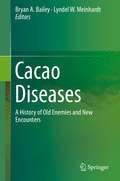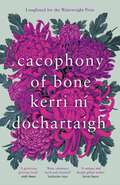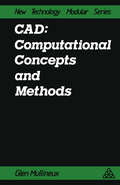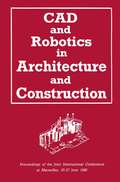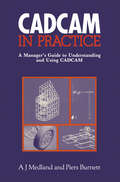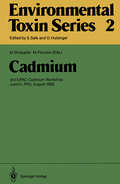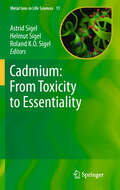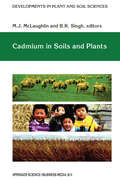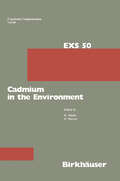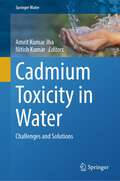- Table View
- List View
Cacao Diseases: A History of Old Enemies and New Encounters
by Bryan A. Bailey Lyndel W. MeinhardtThis book reviews the current state of knowledge concerning cacao pathogens and methods for their management. Topics discussed include the history, biology and genetic diversity of Moniliophthora species (which cause witches’ broom and frosty pod rot) and Phytophthora species (which cause black pod rot) that cause diseases resulting in major losses to cacao production. Emerging pathogens such as Cacao swollen shoot virus and Ceratobasidium theobromae (which causes vascular streak dieback) are also discussed in detail, along with many pathogens of significant local concern. Most of these pathogens represent major risks to global cacao production should they expand into new areas, breaking out of their current limited distributions. By considering cacao diseases as a group, similarities in the available tools and techniques used in their management become apparent, as do their limitations. Gaps in our current knowledge of cacao pathogens and the management of the diseases they cause are detailed, and suggestions for future research directions are provided. This insight allows readers to consider cacao disease threats from a more comprehensive, global perspective and paves the way for an improved synergy of efforts between the various research programs, agencies, and industries, both private and public, with vested interests in cacao production, and cacao farmers.
Cacophony of Bone
by Kerri ni DochartaighLONGLISTED FOR THE WAINWRIGHT PRIZE FOR NATURE WRITING A WATERSTONES BEST BOOK OF 2023: NATURE AND TRAVEL When Kerri and her partner M moved to a small, remote railway cottage in the heart of Ireland they were looking for a home, somewhere to stay put. What followed was a year unlike any other. Cacophony of Bone maps the circle of that year – a journey from one place to another, field notes of a life – from one winter to the next. It is a telling of a changed life, in a changed world – and it is about all that does not change. All that which simply keeps on – living and breathing, nesting and dying – in spite of it all. This is an ode to a year, a place, and a love, that changed a life.
CAD: computational concepts and methods
by Glen. MullineuxIntersection of straight line segments 103 Non-linearity and the intersection of curves 109 Subdivision and box-testing techniques 114 Closed curves 120 A data structure for closed curves 123 The merging of closed curves 125 Chapter 5: Representation of surfaces 133 Introduction 133 Ruled surfaces 134 Coons' patches 136 Surfaces through given points 141 Bezier surface patches 143 B-spline surfaces 148 The DUCT system 149 Problems involved in putting patches together 153 Chapter 6: MODCON: an example system 159 Background to the system 159 The use of primitive shapes 160 Putting primitives together 165 A simple example 170 Operation of the system 171 Limitations of the system 174 Conclusions 176 Chapter 7: Introduction to surface and solid modelling 177 Introduction 177 Types of geometric modeller 177 Solid modelling 181 Obtaining volumetric properties 186 Defining primitive volumetric shapes 188 Hidden line removal and surface shading 190 References 197 Index 199 CHAPTER 1 Review of some basic ideas Introduction The purpose of this chapter is to review some of the standard notation and concepts that underlie the material to be presented later. These are the ideas of mathematics and of numerical mathematics. They are important from a computer aided design (CAD) point of view because the only way in which we can persuade a computer system to deal with geometry for us is by reducing it to a set of numbers which can then be stored and manipulated.
CAD and Robotics in Architecture and Construction: Proceedings of the Joint International Conference at Marseilles, 25–27 June 1986
by A. Bijl O. Akin C.-C. Chen B. Dave S. Pithavadian Y. E. Kalay A. C. Harfmann L. M. Swerdloff R. Krishnamurti G. Schmitt J.-C. Robert J. Weeks U. Flemming R. Coyne T. Glavin M. Rychener L. Koskela R. Hynynen M. Kallavuo K. Kahkönen J. Salokivi A. H. Bridges A. Polistina W. L. Whittaker Y. Hasegawa C. Abel A. H. Slocum R. Kangari E. Bandari M.-C. Wanner M. Skibniewski P. Derrington C. Hendrickson R. F. Woodbury W. T. Keirouz I. J. Oppenheim D. R. Rehak C. F. Earl N. Kano J. L. Crowley P. J. Drazan B. Motazed H.-R. Oeser N. Tanaka M. Saito K. Arai K. Banno T. Ochi S. Kikuchi T. Ueno T. Yoshida S. Suzuki J. MaedaAfter two decades, data processing has finally, and probably forever, found its niche among civil engineering and construction (CEC) professionnals, through word processors, digitizing tables, management software, and increasingly via drawing software and computer-aided design (CAD), recently, robots have even started invading work sites. What are the main trends of CAD and robotics in the field of architecture and civil enginee ring? What type of R&D effort do university and industrial laboratories undertake to devise the professional software that will be on the market in the next three to five years? These are the issues which will be addressed during this symposium. To this effect, we have planned concurrently an equipment and software show, as well as a twofold conference. Robotic is just starting in the field of civil engineering and construction. A pioneer, the Civil Engineering Departement of Carnegie-Mellon University, in the United States, organized the first two international symposia, in 1984 and 1985 in Pittsburgh. This is the third meeting on the subject (this year, however, we have also included CAD). It constitutes the first large international symposium where CAD experts, specialists in architecture and CEC robotics will meet. From this standpoint, it should be an ideal forum for exchanging views and expe riences on a wide range of topics, and we hope it will give rise to novel applications and new syntheses. This symposium is intented for scientists, teachers, students and also for manufacturers and all CEC professionals.
CAD/CAM in Practice: A Manager’s Guide to Understanding and Using CAD/CAM
by Piers Burnett A. J. MedlandLittle more than a decade ago computer-aided design and manufacture (CAD/CAM) was a very esoteric field indeed, not one that was of much practical concern to a manager or industrialist unless his business was on the scale of, say, a major automobile manufacturer or in a field of high technology such as aerospace. Like so much else, this situation was revo lutionized by the invention of the silicon chip, the arrival of the micro processor and the dramatic fall in the cost of computer hardware. Today, CAD/CAM has spread down the market, and down the price scale, to the point at which it is both a feasible and an affordable technology for a wide range of small-and medium-sized companies in areas as various as architec ture and general engineering, plastic moulding and consumer electronics. But the explosion - there is no other word for it - in the variety and capabilities of CAD/CAM systems, and their spectacular climb to the top of the hi-tech hit parade, has placed the potential purchaser and user of the new technology in a difficult position. On the one hand he is assured, not least by the manufacturers of CAD/CAM equipment, that a failure to invest in it will leave his company stranded in the industrial Stone Age.
Cadastre: Geo-Information Innovations in Land Administration
by Tahsin Yomralioglu John McLaughlinThis book highlights the latest improvements in cadastre with examples and case studies from various parts of the world. Authors from different continents, in association with national and international organizations and societies, present the most comprehensive forum to date for cadastre, offering a broad overview of land administration and contemporary perspectives on current research and developments, including surveying, land management, remote sensing and geo-information sciences. Cadastre is a universal concept and is defined as “the work of officially mapping and systemically registering the areas, borders and values of all kinds of land and property”. It is normally a parcel-based and up-to-date land information system containing a record of interests in land with rights, restrictions and responsibilities. It may be established for fiscal and legal purposes, to assist in management for better planning and other administrative purposes, and to enable sustainable development and environmental protection. As such, “cadastre” is an important public inventory documenting the records of ownership, bordering and responsibility regarding the land with “title deeds” to parcels and answering the questions of “whose land, where and how much”.The materials included in the book can support courses at universities and related training institutions worldwide, and will greatly improve readers’ understanding of the scholarly fields involved in cadastre: land registration and management, surveying and mapping, and geo-information management, land governance, land taxation and public administration etc.
Cadaver Dissection with Clinical Applications
by Seth GardnerCadaver Dissection with Clinical Applications is written for students in a professional program that have been given the privilege of dissecting their own cadaver. It discusses dissection techniques, what structures to look for in a particular region and various pitfalls to avoid in the process. The Manual also relates regional anatomical structures with clinical relevance by listing various syndromes, relevant orthopaedic tests, selected X-ray findings and associated pathologies that relate to the region being dissected. It is a terrific resource for all students who will one day see patients in a clinical setting, by first learning anatomical relevance on a cadaver.
Cadaver Dissection with Clinical Applications
by Seth GardnerCadaver Dissection with Clinical Applications is written for students in a professional program that have been given the privilege of dissecting their own cadaver. It discusses dissection techniques, what structures to look for in a particular region and various pitfalls to avoid in the process. The Manual also relates regional anatomical structures with clinical relevance by listing various syndromes, relevant orthopaedic tests, selected X-ray findings and associated pathologies that relate to the region being dissected. It is a terrific resource for all students who will one day see patients in a clinical setting, by first learning anatomical relevance on a cadaver.
CADD and Informatics in Drug Discovery (Interdisciplinary Biotechnological Advances)
by Mithun Rudrapal Johra KhanThis book updates knowledge on recent advances in computational, biophysical and bioinformatics tools/techniques and their practical applications in modern drug design and discovery paradigm. It also encompasses fundamental principles, advanced methodologies and applications of various CADD approaches including several cutting-edge areas; presenting recent developments covering ongoing trends in the field of computer-aided drug discovery. Having contributions by a global team of experts, the book is expected to be an ideal resource for drug discovery scientists, medicinal chemists, pharmacologists, toxicologists, phytochemists, biochemists, biologists, R&D personnel, researchers, students, teachers and those working in the field of drug discovery. It will fill the knowledge gaps that exist in the current CADD approaches and methodologies/ protocols being widely used in both academic and research practices. Further, a special focus on current status of various computational drug design approaches (SBDD, LBDD, de novo drug design, pharmacophore-based search), bioinformatics tools and databases, computational screening and modeling of phytochemicals/natural products, artificial intelligence and machine learning, and network pharmacology and systems biology would certainly guide researchers, students or readers to conduct their research in the emerging area(s) of interest. It is also expected to be highly beneficial to various stakeholders working in the pharmaceutical and biotechnology industries (R&D), the academic as well as research sectors.
The Cadherin Superfamily: Key Regulators of Animal Development and Physiology
by Shintaro T. Suzuki Shinji HiranoThis book presents an overview of the entire field of cadherin research and provides the current basic concept of cadherins. Cadherins have been widely accepted as key regulators of animal development and physiological functions, and it also has become clear that they play essential roles in various human diseases. With contributions by leading scientists, the book covers various aspects of the cadherin superfamily including the history of cadherin research, basic properties of classical cadherins as well as non-classical cadherins, cadherin-associated proteins, and the roles of cadherins in health and diseases. In addition, the book presents some contradictory results and important unanswered questions, and the authors propose their working hypotheses or future directions, to inspire future studies. This volume enables graduate students and young researchers to learn the basics and gain a comprehensive image of the cadherin superfamily, and experts in the field will easily find various topics of interest in relevant areas of study. Additionally, a list of cadherin-related diseases is included for quick reference to cadherins in human diseases.
Cadmium: 3rd IUPAC Cadmium Workshop Juelich, FRG, August 1985 (Environmental Toxin Series #2)
by M. Piscator M. StoepplerOn May 25,1978, the Commission on Toxicology ofthe Division of Clinical Chemistry of the International Union of Pure and Applied Chemistry (IUPAC) established its Subcommittee on Environmental and Occupational Toxicology of Cadmium following aseries of Commission meetings in Kristiansand, Norway. I was appointed chairman ofthe new Subcommittee by the Commission on Toxicology (chairman at that time F. w. Sun derman Jr. ) in which I served from 1977 as an Associate Member and from 1979 as a Titular Member. From the beginning the Cadmium Subcommittee aimed not only at bringing together cadmium experts from around the world for scientific discussions but also at assessing, improving and the harmonization of analysis of cadmium. Due to the membership of many laboratories of the world engaged in scientific and analytical work on cadmium, and following some preliminary studies in a few laboratories from Sweden, The Netherlands and the Federal Republic of Germany, the Cadmium Subcommittee conducted from 1979 to 1985 four international interlaboratory surveys on cadmium analysis in body fluids. Two studies have been performed for cadmium in human and lyophilized bovine blood (1979 to 1980 and 1981) and another two for cadmium in artificial and human urines (1983 and 1985). At present in collaboration with the Selenium Subcommittee and the Subcommittee on Harmonization of Methods, a 5th survey for cadmium, lead and mercury in lyophilized human blood and serum reference materials is con ducted.
Cadmium based II-VI Semiconducting Nanomaterials: Synthesis Routes and Strategies (Topics in Mining, Metallurgy and Materials Engineering)
by Abdul Majid Maryam BibiThis book provides technological perspective and comprehensive overview on the research efforts related to II-VI group cadmium based semiconducting nanomaterials. It describes state-of-the-art information on different synthesis methods for preparation of these materials using a variety of experimental strategies. The effects of synthesis roots on structural, thermal, mechanical, lattice vibronic, electronic, optical and carrier transport characteristics of these nano-structures are systematically analyzed. A wide target readership comprising of students, researchers, scholars, scientists, technicians, academicians, industrialists can benefit from this book, as cadmium based semiconductors possess significant research and industrial interest thanks to their innovative properties.
Cadmium: From Toxicity to Essentiality (Metal Ions in Life Sciences #11)
by Astrid Sigel, Helmut Sigel and Roland KO SigelVolume 11 provides in an authoritative and timely manner in 16 stimulating chapters, written by 40 internationally recognized experts from 11 nations, and supported by more than 2600 references, 35 tables, and over 100 illustrations, many in color, a most up-to-date view on the role of cadmium for life, presently a vibrant research area. MILS-11 covers the bioinorganic chemistry of Cd(II), its biogeochemistry, anthropogenic release into the environment, and speciation in the atmosphere, waters, soils, and sediments. The analytical tools for Cd determination, its imaging in cells, and the use of 113Cd NMR to probe Zn(II) and Ca(II) proteins are summarized, as are Cd(II) interactions with nucleotides, nucleic acids, amino acids, and proteins including metallothioneins. The phytoremediation by Cd(II)-accumulating plants, etc., the toxicology of Cd(II), its damage to mammalian organs, and its role as a carcinogen for humans, are highlighted.
Cadmium in Soils and Plants (Developments in Plant and Soil Sciences #85)
by M. J. McLaughlin B. R. SinghOver forty years ago, concern was first focussed on cadmium contamination of soils, fertilisers and the food chain. Adverse effects on human health were first highlighted nearly 30 years ago in Japan with the outbreak of Itai-itai disease. Since then, substantial research data have accumulated for cadmium on chemistry in soils, additions to soils, uptake by plants, adverse effects on the soil biota and transfer through the food chain. However, this information has never been compiled into a single volume. This was the stimulus for the Kevin G. Tiller Memorial Symposium "Cadmium in Soils, Plants and the Food Chain", held at the University of California, Berkeley, in June 1997 as part of the Fourth International Conference on the Biogeochemistry of Trace Elements. This symposium brought together leading scientists in the field of cadmium behaviour in soils and plants, to review the scientific data in the literature and highlight gaps in our current knowledge of the subject. This series of review papers are presented here and deal with the chemistry of cadmium in soils, the potential for transfer through the food chain and management to minimise this problem. We hope this information provides a sound scientific basis to assist development of policies and regulations for controlling cadmium in the soil environment.
Cadmium in the Environment
by Lars FribergThe focus of this report is upon information essential to the understanding of the toxic action of cadmium and the relationship between dose (exposure) and effects on human beings and animals. The therapy of cadmium poisoning has not been discussed.This review on cadmium in the environment has been performed under a contract between the U.S. Environmental Protection Agency and the Department of Environmental Hygiene of the Karolinska Institute, Sweden. The report is intended to serve as a background paper for a future Air Quality Criteria document on cadmium. Therefore, particular attention has been given to information relevant for the evaluation of risks due to long-term exposure to low concentrations of cadmium. Acute effects from short-term exposure to high concentrations are dealt with briefly. In vitro studies without bearing on the main problem have not been dealt with.The report is not limited to effects from exposure via inhalation. Newly accessible information, showing that large populations may be exposed considerably via the oral route, can elucidate chronic effects of cadmium in general. Man and animals can be victims of secondary exposure through vehicles such as food and water which have been contaminated by cadmium in air.
Cadmium in the Environment
by Lars FribergThe focus of this report is upon information essential to the understanding of the toxic action of cadmium and the relationship between dose (exposure) and effects on human beings and animals. The therapy of cadmium poisoning has not been discussed.This review on cadmium in the environment has been performed under a contract between the U.S. Environmental Protection Agency and the Department of Environmental Hygiene of the Karolinska Institute, Sweden. The report is intended to serve as a background paper for a future Air Quality Criteria document on cadmium. Therefore, particular attention has been given to information relevant for the evaluation of risks due to long-term exposure to low concentrations of cadmium. Acute effects from short-term exposure to high concentrations are dealt with briefly. In vitro studies without bearing on the main problem have not been dealt with.The report is not limited to effects from exposure via inhalation. Newly accessible information, showing that large populations may be exposed considerably via the oral route, can elucidate chronic effects of cadmium in general. Man and animals can be victims of secondary exposure through vehicles such as food and water which have been contaminated by cadmium in air.
Cadmium Interaction with Animal Cells (Springerbriefs In Molecular Science)
by Frank Thévenod David Petering Douglas M. Templeton Wing-Kee Lee Andrea HartwigThis book outlines the interaction of cadmium with the proteome and signalling molecules of mammalian cells. Chapters from expert contributors cover topics such as cadmium chemical biology, membrane receptors and transporters for cadmium and cadmium complexes, and targets of cadmium toxicity. Students and researchers working in bioinorganic chemistry will find this book an important account.
Cadmium System-Nummer 33 (Gmelin Handbook of Inorganic and Organometallic Chemistry - 8th edition #C-d / 0)
by R. J. MeyerCadmium Toxicity in Water: Challenges and Solutions (Springer Water)
by Amrit Kumar Jha Nitish KumarThis book sheds light on this global environmental issue and proposes solutions to reduce contamination through multi-disciplinary approaches. Water is considered a vital resource because it is necessary for all aspects of human and ecosystem survival. However, due to natural processes and anthropogenic activities, various pollutants have been added to the groundwater system. Among these, heavy metals are some of the most serious pollutants. Cd, a toxic heavy metal used in Ni-Cd batteries, the coloration of plastic and various discarded electronic products released into the water system causes serious health issues. The chronic exposure to Cd produces a wide variety of acute and chronic effects in humans.This edited book brings together a diverse group of researchers to address the challenges posed by global mass poisoning caused by cadmium contamination of water bodies. This book contains three sections. The first section describes the different sources and distribution of cadmium in water ecosystem. The second section explains the health risks linked to cadmium toxicity. The third section addresses sustainable cadmium toxicity mitigation strategies and the potential applications of recent biological technology in providing solutions.
Cadmium Toxicity Mitigation
by Amrit Kumar Jha Nitish KumarThis book covers cadmium contamination of soil and plants, its sources, acute and long-term impacts on the environment and human health, and overall challenges posed by the global poisoning issue. Cadmium is among the elements that have been most broadly used by man over time, which has led to extensive pollution of surface soils, mainly associated with the mining and smelting of the metal and the addition of organic cadmium compounds to petrol. The release of cadmium into the atmosphere from various high-temperature processes has also led to surface contamination on a regional and even global scale. Cadmium is particularly firmly bound to humic matter in organic-rich soil and to iron oxides in mineral soil and is rather immobile in the soil unless present at very high concentrations. Plants grown on cadmium-rich soils incorporate cadmium, thus increasing the concentration of cadmium in crop plants. Cadmium thus enters the food chain through the consumption of plant material, which poses important health risks to humans and animals. In this book, readers will find out about the latest mitigation strategies, including a multi-disciplinary approach to address cadmium contamination. Recent methods in cadmium detoxification, speciation, and molecular mechanisms are included, and the book offers the knowledge required for efficient risk assessment, prevention, and countermeasure. Divided into 3 parts, this book brings together expert contributions on cadmium toxicity. In the first part, readers will find out about the different sources and distribution of cadmium in soil and plant ecosystems. The second part of the book outlines the health risks linked to cadmium toxicity, and in the final part, readers will discover sustainable cadmium toxicity mitigation strategies and potential applications of recent biological technology in providing solutions. This book is a valuable resource for students, academics, researchers, and environmental professionals doing fieldwork on cadmium contamination throughout the world.
Caesar's Last Breath: The Epic Story of The Air Around Us
by Sam Kean** GUARDIAN SCIENCE BOOK OF THE YEAR 2017 **‘Popular science at its best’Mail on Sunday‘Eminently accessible and enjoyable’ObserverWith every breath, you literally inhale the history of the world. On the ides of March, 44 BC, Julius Caesar died of stab wounds in the Roman Senate, but the story of his last breath is still unfolding. In fact, you're probably inhaling some of it now. Of the sextillions of molecules entering or leaving your lungs at this moment, some might also bear traces of Cleopatra's perfumes, German mustard gas, particles exhaled by dinosaurs or emitted by atomic bombs, even remnants of stardust from the universe's creation. In Caesar’s Last Breath, New York Times bestselling author Sam Kean takes us on a journey through the periodic table, around the globe and across time to tell the epic story of the air we breathe.
